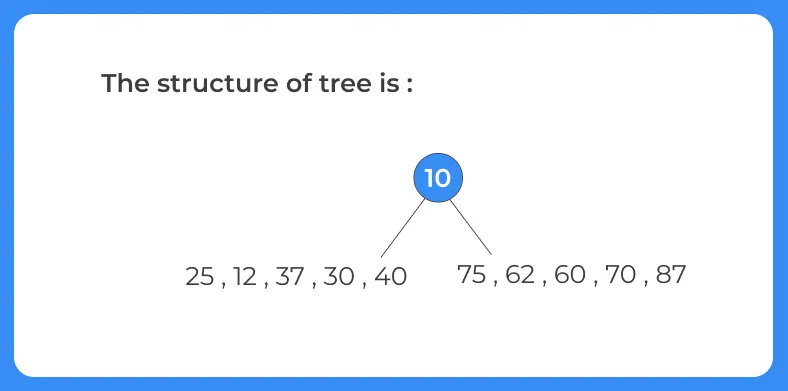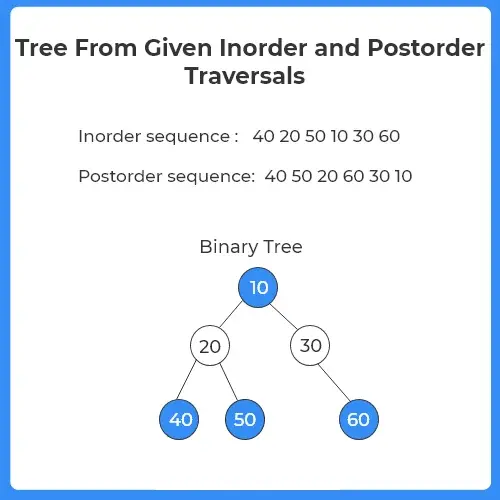Construct Tree from given Postorder and Inorder Traversals
Construct Tree From Given Inorder and Postorder Traversals in Java
There are three types of traversals in a tree: Inorder, Preorder and Postorder traversal. A tree can be formed with any two tree traversals in which one of them being the in order traversal.

Construct Tree From Given Inorder and Postorder Traversals
Example
Given traversals:
Postorder: 12, 30, 40, 37, 25, 60, 70, 62, 87, 75, 50
Inorder:12, 25, 30, 37, 40, 50, 60, 62, 70, 75, 87
1. The last element in the postorder traversal is the root of the tree.
So, here 50 will be the root of the tree.
2. We will find the index of 50 in the inorder traversal.The index found is 5. Let this index is denoted by ‘pos’.
3. All the elements to the left of this index ( from 0 to 4 index) will be in the left subtree of 50.
4. And all the elements to the right of this index ( from 6 to 10) will be in the right subtree of 50.

Now, we will divide preorder and inorder array in two parts.
One is for the left subtree and other is for the right subtree.
Let
- psi: starting index for preorder array
- pei: ending index for preorder array
- isi: starting index of inorder array
- iei: ending index of preorder array
- clc: Number of elements in the left subtree
Clearly, clc= pos – isi;
For left subtree:
Postorder array: from index psi, psi + clc – 1
Inorder array: from index isi, isi + clc -1
For right subtree:
Postorder array: from index psi+clc, pei – 1
Inorder array: from index isi + clc + 1, iei
Using the above arrays, all the steps are recursively repeated.
The following binary tree is obtained:

Code For Binary Search Tree
public class Main
{
// Binary tree class
public static class BinaryTree
{
// Node class
public class Node
{
int data;
Node left;
Node right;
public Node (int data)
{
this.data = data;
this.left = null;
this.right = null;
}
}
private Node root;
private int size;
public BinaryTree (int[]post, int[]in)
{
this.root =
this.construct (post, 0, post.length -1, in, 0, in.length-1);
}
private Node construct (int[]post, int psi, int pei, int[]in, int isi,
int iei)
{
// Base case
if (psi > pei)
{
return null;
}
Node node = new Node (post[pei]);
node.left = null;
node.right = null;
this.size++;
// Searching post[pei] in inorder array
int pos = -1;
for (int i = isi; i <= iei; i++)
{
if (in[i] == node.data)
{
pos = i;
break;
}
}
// Number of elements in left subtree
int clc = pos-isi;
// Left subtree
node.left =
this.construct (post, psi, psi + clc-1, in, isi, isi + clc-1);
// Right subtree
node.right =
this.construct (post, psi + clc, pei-1, in, isi + clc + 1, iei);
return node;
}
// Postorder tree traversal
public void postOrder ()
{
postOrder (this.root);
}
private void postOrder (Node node)
{
if (node == null)
{
return;
}
postOrder (node.left);
postOrder (node.right);
System.out.print (node.data + " ");
}
}
public static void main (String[]args) throws Exception
{
// Construct binary tree
int[] in = { 12, 25, 30, 37, 40, 50, 60, 62, 70, 75, 87 };
int[] post = { 12, 30, 40, 37, 25, 60, 70, 62, 87, 75, 50 };
BinaryTree bt = new BinaryTree (post, in);
System.out.println("The new tree constructed is (Postorder) : ");
bt.postOrder ();
}
}
Output :
The new tree constructed is (Postorder) : 12 30 40 37 25 60 70 62 87 75 50


